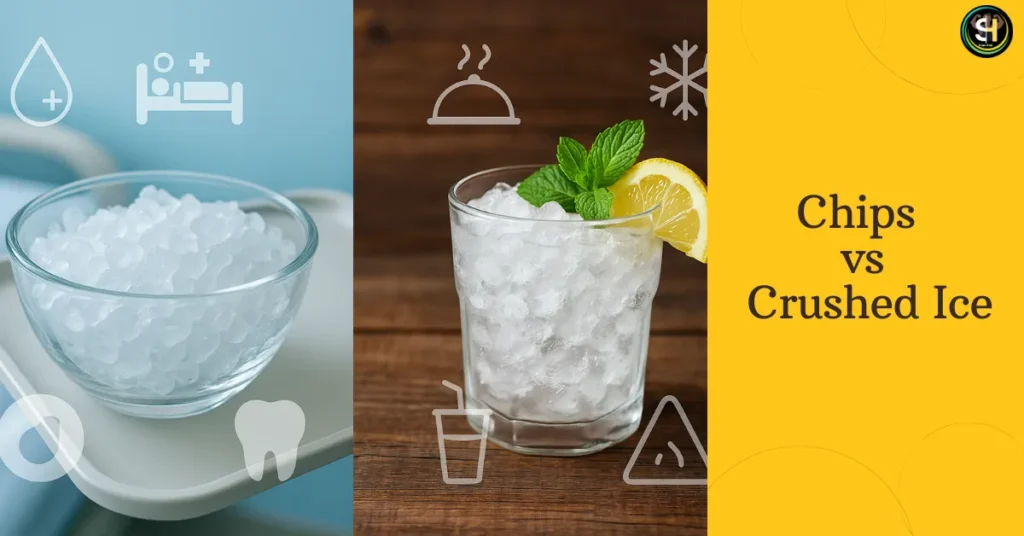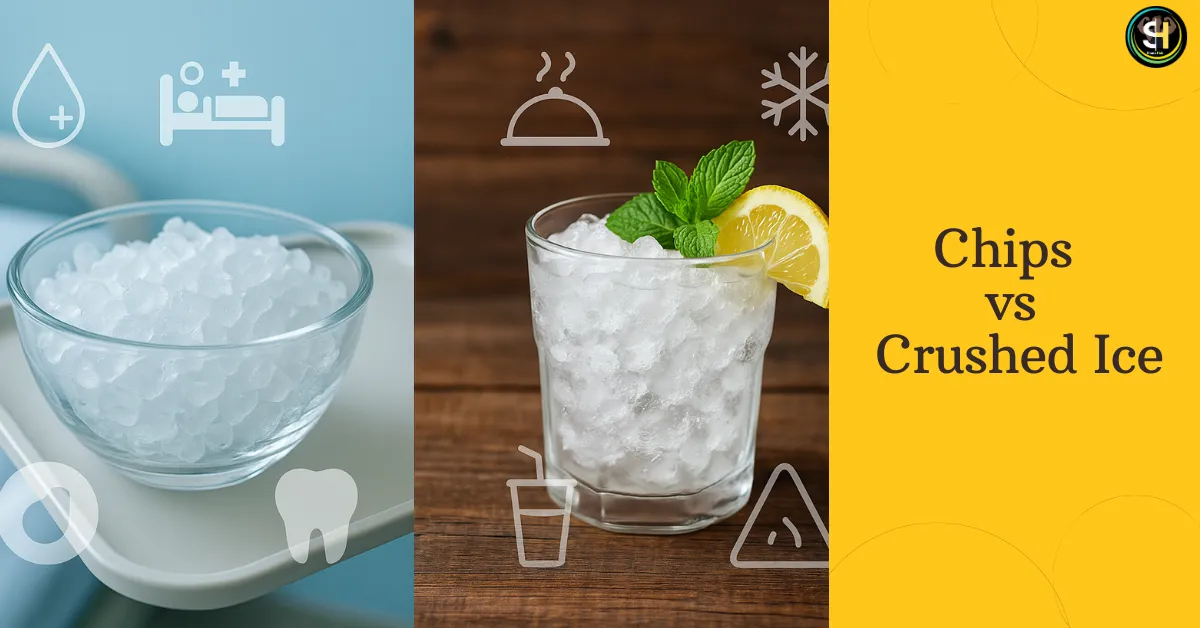
When it comes to hydration and therapeutic cooling, ice chips and crushed ice are often used interchangeably. But in reality, these two forms of ice have distinct textures, health impacts, and medical applications. Whether you’re recovering from surgery, dealing with dehydration, or simply trying to stay cool, the form of ice you choose can make a difference.
In this, we’ll compare ice chips vs. crushed ice across a variety of health and wellness factors. From dental safety to post-operative care, oral comfort to hydration, we’ll explore which form of ice is better for your needs—and why.
What Are Ice Chips and Crushed Ice?
Let’s start by defining the difference:
Ice Chips
Ice chips are thin, flaked shards of ice—small, soft, and easy to chew or suck on. They melt quickly and are commonly found in hospitals because they are easier to consume, especially for patients recovering from surgery or experiencing nausea.
Crushed Ice
Crushed ice consists of larger, irregular chunks of broken-down ice cubes. It’s often made using a blender or ice-crushing machine and is widely used in beverages, fast food, and home kitchens.
Why the Comparison Matters: Health, Safety, and Recovery
Though they both originate from frozen water, ice chips and crushed ice serve different purposes in health and wellness:
- Hospitals prefer ice chips for patient safety and comfort.
- Restaurants and homes use crushed ice more commonly in drinks and desserts.
- People with cravings or specific health conditions may unknowingly harm their teeth or increase health risks depending on which they choose.
Let’s break down the comparison by specific health categories.
1. Hydration Support
✅ Winner: Ice Chips
When you’re dehydrated or can’t tolerate drinking fluids, ice chips offer slow, safe hydration. Their thin texture melts easily, releasing small amounts of water that can be absorbed gently by the body.
Best for:
- Post-surgery recovery
- Chemotherapy patients
- Pregnant women with morning sickness
- People with vomiting, diarrhea, or fever
📌 Scientific Insight: According to the National Cancer Institute, sucking on ice chips can help patients who are “NPO” (not allowed to eat or drink) maintain oral moisture and prevent dry mouth.
❌ Crushed Ice Drawbacks:
Larger chunks may be harder to swallow, increasing the risk of choking or aspiration in vulnerable individuals.
Read This Also: Berberine vs. Berbere
2. Oral Health and Tooth Safety
✅ Winner: Ice Chips (When Not Chewed Hard)
Chewing on ice is a common habit, but it can damage tooth enamel, cause cracks, or even break fillings—especially with crushed ice. Ice chips, being thinner and easier to melt, are less likely to harm teeth if consumed without aggressive chewing.
Key Tip: Let ice chips melt in your mouth rather than biting them.
📌 The American Dental Association (ADA) warns against chewing ice of any kind, but notes that smaller, softer forms like ice chips pose a lower risk of dental trauma.
3. Use in Medical Treatments
✅ Winner: Ice Chips
Hospitals choose ice chips over crushed ice for a reason. Ice chips are:
- Easier to control in dosage (1 tsp = consistent amount)
- Less likely to cause choking
- Ideal for patients on fluid restrictions or oral rest
Common medical uses include:
- Post-operative care (especially after anesthesia)
- Managing oral mucositis during chemotherapy
- Comfort care in hospice settings
- Cooling the mouth and throat during fevers or infections
4. Nausea and Vomiting Relief
✅ Winner: Ice Chips
When your stomach is unsettled, drinking water can feel impossible. Ice chips offer a way to hydrate slowly without overwhelming the digestive system. This is especially helpful for:
- Pregnant women
- Cancer patients
- People with food poisoning or stomach flu
🧊 Bonus: The slow melting of ice chips can help calm the vagus nerve, which can reduce the urge to vomit.
5. Thermoregulation and Fever Relief
✅ Winner: Tie
Both ice chips and crushed ice help regulate body temperature by:
- Cooling the body from the inside out
- Reducing internal heat during fevers or hot weather
- Offering a refreshing sensation during heatwaves or exercise recovery
❄️ Ice chips are easier to keep in the mouth, while crushed ice can be more satisfying when chewed in non-medical scenarios.
6. Use in Weight Loss and Appetite Control
✅ Winner: Ice Chips
Ice chips can act as a zero-calorie appetite suppressant by:
- Keeping the mouth busy
- Mimicking snacking without adding calories
- Delaying hunger signals through oral stimulation
📌 Some dietitians recommend ice chips as a behavioral tool during intermittent fasting or calorie restriction.
⚠️ Crushed ice may be more tempting to chew, which could lead to dental damage over time if used habitually.
7. Safety for People with Dysphagia or Swallowing Disorders
✅ Winner: Ice Chips
People with dysphagia (swallowing difficulty) need carefully monitored food and fluid textures. Ice chips melt into a controlled, small amount of liquid, reducing the risk of choking.
🩺 Always consult a speech-language pathologist before offering ice to a person with swallowing disorders.
8. Pica and Ice-Craving Disorders
Pagophagia, or compulsive ice chewing, is often linked to iron-deficiency anemia. People with this condition tend to chew on large amounts of crushed ice, potentially damaging their teeth.
✅ Ice Chips as a Safer Alternative:
If you experience ice cravings, choose ice chips over crushed ice to reduce the risk of tooth injury and schedule a medical checkup to test your iron levels.
How to Make Ice Chips and Crushed Ice at Home
🧊 How to Make Ice Chips
- Freeze water in a shallow tray or flat container
- Once frozen, use a clean mallet or spoon to gently chip into flakes
- Store in a freezer-safe container for later use
You can also use a flake ice machine or snow cone maker for larger quantities.
🧊 How to Make Crushed Ice
- Freeze ice cubes
- Blend using the pulse mode in a high-speed blender or food processor
- Store in a cooler or serve immediately in drinks
Creative and Functional Uses of Both Chips and Crushed Ice
| Use Case | Best Ice Type | Why? |
| Post-surgery hydration | Ice Chips | Safer, melts slowly |
| Dental comfort | Ice Chips | Less abrasive |
| Cocktail presentation | Crushed Ice | Looks & feels better |
| Sore throat relief | Ice Chips | Less irritating |
| Smoothie making | Crushed Ice | Blends easily |
| Cooling compress | Either | Wrap in towel for relief |
| Chemo-induced mouth sores | Ice Chips | Reduces mucositis risk |
Which Is Better for You? Final Verdict Of Chips and Crushed Ice
| Category | Winner |
| Medical Hydration | ✅ Ice Chips |
| Dental Safety | ✅ Ice Chips |
| Fever Relief | 🤝 Tie |
| Nausea Relief | ✅ Ice Chips |
| Weight Loss Tool | ✅ Ice Chips |
| Everyday Beverage Use | ✅ Crushed Ice |
| Smoothie Prep | ✅ Crushed Ice |
| Ice Cravings (Pica) | ✅ Ice Chips (with iron screening) |
Conclusion: Choose Ice Wisely for Your Health Goals
While both ice chips and crushed ice offer hydration and cooling benefits, ice chips stand out for their medical safety, oral comfort, and therapeutic uses. From hospitals to home care, ice chips are the preferred choice for hydration when drinking fluids is not ideal.
Crushed ice, while refreshing and satisfying in drinks, poses more risks—especially for teeth—and is best used in moderation or with awareness of its impact. So the next time you reach for a frozen treat, ask yourself: Is this just for refreshment—or for healing? The answer may guide you toward the safer, more beneficial option—ice chips.
Visit Our Instagram
